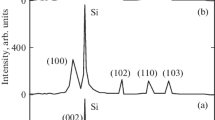Abstract
The interpretation of the nature of self-activated luminescence spectra of CdS:O is given on the basis of the band anticrossing theory, making it possible to take into account the effect of isoelectron oxygen impurity on the modification of the band structure. The bands of self-activated luminescence (SA and SAL) of CdS:O similar to those of ZnS-ZnSe:O are revealed. In the presence of dissolved oxygen OS, the presence of two additional H and L components is revealed in the composition of SA bands, which are owed to the transitions from E + and E − subbands of the CdS:O split conduction band to the recombination level E SA. Their spectral dependence on the dissolved-oxygen concentration [OS] is determined. It is shown that the CdS green edge emission is similar to that of SAL; however, in contrast to ZnS-ZnSe:O, there is no H component in the fundamental-absorption region of the crystal. The analysis of the composition of the SA and SAL centers in the CdS crystals shows their equivalence to ZnS(ZnSe). From the experimental data, the position of the oxygen localized level E 0, a decrease in the band gap E g with [OS], and the band model of CdS:O are found. This study supplements similar investigations carried out previously for ZnS-ZnSe:O.
Similar content being viewed by others
References
K. M. Yu, W. Walukiewicz, J. Wu, W. Shan, J. W. Beeman, M. A. Scarpulla, O. D. Dubon, and P. Becla, Phys. Rev. Lett. 91, 246403 (2003).
W. Sahn, W. Walukiewicz, J. W. Ager III, E. E. Haller, J. F. Geisz, D. J. Friedman, and J. M. Olson, Phys. Rev. Lett. 82, 1221 (1999).
J. Wu, W. Walukiewicz, and E. E. Haller, Phys. Rev. B 65, 233210 (2002).
D. A. Mideros, Candidate’s Dissertation (Mosc. Energ. Inst., Moscow, 2008).
N. K. Morozova, I. A. Karetnikov, K. V. Golub, N. D. Danilevich, V. M. Lisitsyn, and V. I. Oleshko, Fiz. Tekh. Poluprovodn. 39, 513 (2005) [Semiconductors 39, 485 (2005)].
N. K. Morozova, D. A. Mideros, E. M. Gavrishchuk, and V. G. Galstyan, Fiz. Tekh. Poluprovodn. 42, 131 (2008) [Semiconductors 42, 131 (2008)].
N. K. Morozova, D. A. Mideros, V. G. Galstyan, and E. M. Gavrishchuk, Fiz. Tekh. Poluprovodn. 42, 1039 (2008) [Semiconductors 42, 1023 (2008)].
N. K. Morozova, D. A. Mideros, and N. D. Danilevich, Fiz. Tekh. Poluprovodn. 43, 174 (2009) [Semiconductors 43, 162 (2009)].
N. K. Morozova, V. G. Galstyan, N. D. Danilevich, and V. M. Semenov, Izv. Vyssh. Uchebn. Zaved. Élektron., No. 1(75), 3 (2009).
N. K. Morozova, N. D. Danilevich, and V. M. Semenov, in Proc. of the 39th Intern. Sci.-Tech. Work Shop on Noise and Degradation Processes in Semiconductor Devices (Mosc. Energ. Inst., Moscow, 2009), p. 132.
N. K. Morozova, V. V. Blinov, E. M. Gavrishchuk, V. G. Galstyan, V. G. Plotnichenko, I. A. Karetnikov, and V. S. Zimogorskii, Neorg. Mater. 37, 1439 (2001) [Inorg. Mater. 37, 1227 (2001)].
N. K. Morozova, I. A. Karetnikov, and E. M. Gavrishchuk, Neorg. Mater. 35, 917 (1999) [Inorg. Mater. 35, 775 (1999)].
Physics and Chemistry of II–VI Compounds, Ed. by S. A. Medvedev (Mir, Moscow, 1970) [in Russian].
V. A. Teplitskii, Candidate’s Dissertation (Mosc. Energ. Inst., Moscow, 1989).
N. K. Morozova, A. V. Morozov, L. D. Nazarova, N. D. Danilevich, and I. A. Karetnikov, Fiz. Tekh. Poluprovodn. 28, 1699 (1994) [Semiconductors 28, 944 (1994)].
A. V. Morozov, Candidate’s Dissertation (Mosc. Energ. Inst., Moscow, 1993).
V. S. Zimogorskii, N. A. Yashtulov, and V. V. Blinov, in Proc. of the 30th Intern. Sci.-Tech. Seminar on Noise and Degradation Processes in Semiconductor Devices (Mosc. Energ. Inst., Moscow, 2000).
N. K. Morozova, A. V. Morozov, and V. S. Zimogorskii, Neorg. Mater. 29, 1014 (1993).
D. A. Mideros, Nguen Chan Kha, and N. K. Morozova, in Proc. of the 38th Intern. Sci.-Tech. Seminar on Noise and Degradation Processes in Semiconductor Devices (Mosc. Energ. Inst., Moscow, 2008), p. 138.
Jingo Li and Su-Huai Wei, Phys. Rev. B 73, 041201 (2006).
M. Yu. Rebrov, V. T. Bublik, T. A. Teplitskii, and E. V. Markov, Dokl. AN SSSR, Ser. Fiz. 307, 597 (1989).
N. K. Morozova and D. A. Mideros, Izv. Vyssh. Uchebn. Zaved., Ser. Élektron., No. 3, 3 (2008).
K. Akimoto, T. Miyajima, and Y. Mori, Phys. Rev. B 39,3138 (1989).
I. V. Ostrovskii, Soros. Obrazov. Zh. Fiz., No. 1, 95 (1998).
Author information
Authors and Affiliations
Additional information
Original Russian Text © N.K. Morozova, N.D. Danilevich, 2010, published in Fizika i Tekhnika Poluprovodnikov, 2010, Vol. 44, No. 4, pp. 458–462.
Rights and permissions
About this article
Cite this article
Morozova, N.K., Danilevich, N.D. Features of self-activated luminescence spectra of CdS:O in the context of band anticrossing theory. Semiconductors 44, 438–443 (2010). https://doi.org/10.1134/S1063782610040056
Received:
Accepted:
Published:
Issue Date:
DOI: https://doi.org/10.1134/S1063782610040056




